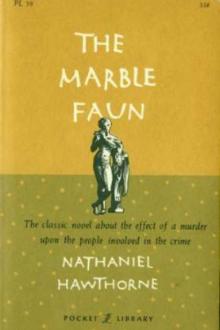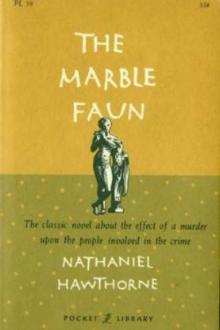The Marble Faun, vol 2 by Nathaniel Hawthorne (smallest ebook reader TXT) 📖

- Author: Nathaniel Hawthorne
- Performer: -
Book online «The Marble Faun, vol 2 by Nathaniel Hawthorne (smallest ebook reader TXT) 📖». Author Nathaniel Hawthorne
“She! she commit a crime!” cried the young artist. “Can you look at the innocent anguish in her face, and ask that question? No; but, as I read the mystery, a man has been slain in her presence, and the blood, spurting accidentally on her white robe, has made a stain which eats into her life.”
“Then, in the name of her patron saint,” exclaimed the picture dealer, “why don’t she get the robe made white again at the expense of a few baiocchi to her washerwoman? No, no, my dear Panini. The picture being now my property, I shall call it ‘The Signorina’s Vengeance.’ She has stabbed her lover overnight, and is repenting it betimes the next morning. So interpreted, the picture becomes an intelligible and very natural representation of a not uncommon fact.”
Thus coarsely does the world translate all finer griefs that meet its eye. It is more a coarse world than an unkind one.
But Hilda sought nothing either from the world’s delicacy or its pity, and never dreamed of its misinterpretations. Her doves often flew in through the windows of the tower, winged messengers, bringing her what sympathy they could, and uttering soft, tender, and complaining sounds, deep in their bosoms, which soothed the girl more than a distincter utterance might. And sometimes Hilda moaned quietly among the doves, teaching her voice to accord with theirs, and thus finding a temporary relief from the burden of her incommunicable sorrow, as if a little portion of it, at least, had been told to these innocent friends, and been understood and pitied.
When she trimmed the lamp before the Virgin’s shrine, Hilda gazed at the sacred image, and, rude as was the workmanship, beheld, or fancied, expressed with the quaint, powerful simplicity which sculptors sometimes had five hundred years ago, a woman’s tenderness responding to her gaze. If she knelt, if she prayed, if her oppressed heart besought the sympathy of divine womanhood afar in bliss, but not remote, because forever humanized by the memory of mortal griefs, was Hilda to be blamed? It was not a Catholic kneeling at an idolatrous shrine, but a child lifting its tear-stained face to seek comfort from a mother.
CHAPTER XXXVII THE EMPTINESS OF PICTURE GALLERIES
Hilda descended, day by day, from her dove-cote, and went to one or another of the great old palaces,—the Pamfili Doria, the Corsini, the Sciarra, the Borghese, the Colonna,—where the doorkeepers knew her well, and offered her a kindly greeting. But they shook their heads and sighed, on observing the languid step with which the poor girl toiled up the grand marble staircases. There was no more of that cheery alacrity with which she used to flit upward, as if her doves had lent her their wings, nor of that glow of happy spirits which had been wont to set the tarnished gilding of the picture frames and the shabby splendor of the furniture all a-glimmer, as she hastened to her congenial and delightful toil.
An old German artist, whom she often met in the galleries, once laid a paternal hand on Hilda’s head, and bade her go back to her own country.
“Go back soon,” he said, with kindly freedom and directness, “or you will go never more. And, if you go not, why, at least, do you spend the whole summer-time in Rome? The air has been breathed too often, in so many thousand years, and is not wholesome for a little foreign flower like you, my child, a delicate wood-anemone from the western forest-land.”
“I have no task nor duty anywhere but here,” replied Hilda. “The old masters will not set me free!”
“Ah, those old masters!” cried the veteran artist, shaking his head. “They are a tyrannous race! You will find them of too mighty a spirit to be dealt with, for long together, by the slender hand, the fragile mind, and the delicate heart, of a young girl. Remember that Raphael’s genius wore out that divinest painter before half his life was lived. Since you feel his influence powerfully enough to reproduce his miracles so well, it will assuredly consume you like a flame.”
“That might have been my peril once,” answered Hilda. “It is not so now.”
“Yes, fair maiden, you stand in that peril now!” insisted the kind old man; and he added, smiling, yet in a melancholy vein, and with a German grotesqueness of idea, “Some fine morning, I shall come to the Pinacotheca of the Vatican, with my palette and my brushes, and shall look for my little American artist that sees into the very heart of the grand pictures! And what shall I behold? A heap of white ashes on the marble floor, just in front of the divine Raphael’s picture of the Madonna da Foligno! Nothing more, upon my word! The fire, which the poor child feels so fervently, will have gone into her innermost, and burnt her quite up!”
“It would be a happy martyrdom!” said Hilda, faintly smiling. “But I am far from being worthy of it. What troubles me much, among other troubles, is quite the reverse of what you think. The old masters hold me here, it is true, but they no longer warm me with their influence. It is not flame consuming, but torpor chilling me, that helps to make me wretched.”
“Perchance, then,” said the German, looking keenly at her, “Raphael has a rival in your heart? He was your first love; but young maidens are not always constant, and one flame is sometimes extinguished by another!” Hilda shook her head, and turned away. She had spoken the truth, however, in alleging that torpor, rather than fire, was what she had to dread. In those gloomy days that had befallen her, it was a great additional calamity that she felt conscious of the present dimness of an insight which she once possessed in more than ordinary measure. She had lost—and she trembled lest it should have departed forever—the faculty of appreciating those great works of art, which heretofore had made so large a portion of her happiness. It was no wonder.
A picture, however admirable the painter’s art, and wonderful his power, requires of the spectator a surrender of himself, in due proportion with the miracle which has been wrought. Let the canvas glow as it may, you must look with the eye of faith, or its highest excellence escapes you. There is always the necessity of helping out the painter’s art with your own resources of sensibility and imagination. Not that these qualities shall really add anything to what the master has effected; but they must be put so entirely under his control, and work along with him to such an extent, that, in a different mood, when you are cold and critical, instead of sympathetic, you will be apt to fancy that the loftier merits of the picture were of your own dreaming, not of his creating.
Like all revelations of the better life, the adequate perception of a great work of art demands a gifted simplicity of vision. In this, and in her self-surrender, and the depth and tenderness of her sympathy, had lain Hilda’s remarkable power as a copyist of the old masters. And now that her capacity of emotion was choked up with a horrible experience, it inevitably followed that she should seek in vain, among those friends so venerated and beloved, for the marvels which they had heretofore shown her. In spite of a reverence that lingered longer than her recognition, their poor worshipper became almost an infidel, and sometimes doubted whether the pictorial art be not altogether a delusion.
For the first time in her life, Hilda now grew acquainted with that icy demon of weariness, who haunts great picture galleries. He is a plausible Mephistopheles, and possesses the magic that is the destruction of all other magic. He annihilates color, warmth, and, more especially, sentiment and passion, at a touch. If he spare anything, it will be some such matter as an earthen pipkin, or a bunch of herrings by Teniers; a brass kettle, in which you can see your rice, by Gerard Douw; a furred robe, or the silken texture of a mantle, or a straw hat, by Van Mieris; or a long-stalked wineglass, transparent and full of shifting reflection, or a bit of bread and cheese, or an over-ripe peach with a fly upon it, truer than reality itself, by the school of Dutch conjurers. These men, and a few Flemings, whispers the wicked demon, were the only painters. The mighty Italian masters, as you deem them, were not human, nor addressed their work to human sympathies, but to a false intellectual taste, which they themselves were the first to create. Well might they call their doings “art,” for they substituted art instead of nature. Their fashion is past, and ought, indeed, to have died and been buried along with them.
Then there is such a terrible lack of variety in their subjects. The churchmen, their great patrons, suggested most of their themes, and a dead mythology the rest. A quarter part, probably, of any large collection of pictures consists of Virgins and infant Christs, repeated over and over again in pretty much an identical spirit, and generally with no more mixture of the Divine than just enough to spoil them as representations of maternity and childhood, with which everybody’s heart might have something to do. Half of the other pictures are Magdalens, Flights into Egypt, Crucifixions, Depositions from the Cross, Pietas, Noli-me-tangeres, or the Sacrifice of Abraham, or martyrdoms of saints, originally painted as altar-pieces, or for the shrines of chapels, and woefully lacking the accompaniments which the artist haft in view.
The remainder of the gallery comprises mythological subjects, such as nude Venuses, Ledas, Graces, and, in short, a general apotheosis of nudity, once fresh and rosy perhaps, but yellow and dingy in our day, and retaining only a traditionary charm. These impure pictures are from the same illustrious and impious hands that adventured to call before us the august forms of Apostles and Saints, the Blessed Mother of the Redeemer, and her Son, at his death, and in his glory, and even the awfulness of Him, to whom the martyrs, dead a thousand years ago, have not yet dared to raise their eyes. They seem to take up one task or the other w the disrobed woman whom they call Venus, or the type of highest and tenderest womanhood in the mother of their Saviour with equal readiness, but to achieve the former with far more satisfactory success. If an artist sometimes produced a picture of the Virgin, possessing warmth enough to excite devotional feelings, it was probably the object of his earthly love to whom he thus paid the stupendous and fearful homage of setting up her portrait to be worshipped, not figuratively as a mortal, but by religious souls in their earnest aspirations towards Divinity. And who can trust the religious sentiment of Raphael, or receive any of his Virgins as heaven-descended likenesses, after seeing, for example, the Fornarina of the Barberini Palace, and feeling how sensual the artist must have been to paint such a brazen trollop of his own accord, and lovingly? Would the Blessed Mary reveal herself to his spiritual vision, and favor him with sittings alternately with that type of glowing earthliness, the Fornarina?
But no sooner have we given expression to this irreverent criticism, than a throng of spiritual faces look reproachfully upon us. We see cherubs by Raphael, whose baby innocence could only have been nursed in paradise; angels by Raphael as innocent as they, but whose serene intelligence embraces both earthly and celestial things; madonnas by Raphael, on whose lips he has impressed a holy and delicate reserve, implying sanctity on earth, and into whose soft eyes
 Reading books romantic stories you will plunge into the world of feelings and love. Most of the time the story ends happily. Very interesting and informative to read books historical romance novels to feel the atmosphere of that time.
Reading books romantic stories you will plunge into the world of feelings and love. Most of the time the story ends happily. Very interesting and informative to read books historical romance novels to feel the atmosphere of that time.




Comments (0)